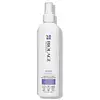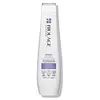What's inside
What's inside
 Key Ingredients
Key Ingredients

No key ingredients
 Benefits
Benefits

 Concerns
Concerns

 Ingredients Side-by-side
Ingredients Side-by-side

Water
Skin ConditioningPropylene Glycol
HumectantPhenoxyethanol
PreservativePolyquaternium-37
Amodimethicone
Oleth-5
EmulsifyingPropylene Glycol Dicaprylate/Dicaprate
EmollientMethylparaben
PreservativePolyquaternium-11
Ethylhexyl Methoxycinnamate
UV AbsorberPanthenol
Skin ConditioningEthylparaben
PreservativePPG-1 Trideceth-6
Skin ConditioningParfum
MaskingCetrimonium Chloride
AntimicrobialTriethanolamine
BufferingTrideceth-12
EmulsifyingDisodium EDTA
Limonene
PerfumingTocopherol
AntioxidantHexyl Cinnamal
PerfumingCoumarin
PerfumingLinalool
PerfumingButylphenyl Methylpropional
PerfumingBenzyl Alcohol
PerfumingHydroxycitronellal
PerfumingAmyl Cinnamal
PerfumingAloe Barbadensis Extract
Skin ConditioningWater, Propylene Glycol, Phenoxyethanol, Polyquaternium-37, Amodimethicone, Oleth-5, Propylene Glycol Dicaprylate/Dicaprate, Methylparaben, Polyquaternium-11, Ethylhexyl Methoxycinnamate, Panthenol, Ethylparaben, PPG-1 Trideceth-6, Parfum, Cetrimonium Chloride, Triethanolamine, Trideceth-12, Disodium EDTA, Limonene, Tocopherol, Hexyl Cinnamal, Coumarin, Linalool, Butylphenyl Methylpropional, Benzyl Alcohol, Hydroxycitronellal, Amyl Cinnamal, Aloe Barbadensis Extract
Water
Skin ConditioningCetearyl Alcohol
EmollientGlycerin
HumectantBehentrimonium Methosulfate
Amodimethicone
Behentrimonium Chloride
PreservativeParfum
MaskingIsopropyl Alcohol
SolventAloe Barbadensis Leaf Juice
Skin ConditioningTrideceth-6
EmulsifyingLimonene
PerfumingChlorhexidine Dihydrochloride
AntimicrobialCetrimonium Chloride
AntimicrobialHexyl Cinnamal
PerfumingCitric Acid
BufferingCoumarin
PerfumingLinalool
PerfumingPassiflora Edulis Fruit Juice
Skin ConditioningBisabolol
MaskingWater, Cetearyl Alcohol, Glycerin, Behentrimonium Methosulfate, Amodimethicone, Behentrimonium Chloride, Parfum, Isopropyl Alcohol, Aloe Barbadensis Leaf Juice, Trideceth-6, Limonene, Chlorhexidine Dihydrochloride, Cetrimonium Chloride, Hexyl Cinnamal, Citric Acid, Coumarin, Linalool, Passiflora Edulis Fruit Juice, Bisabolol
Ingredients Explained
These ingredients are found in both products.
Ingredients higher up in an ingredient list are typically present in a larger amount.
This water-soluble silicone is used for its hydrating and softening properties. It is used to add a silky feel to skincare products and has great benefits for haircare.
In haircare, this ingredient:
- Adds shine
- Protects color
- Offers thermal protection
- Boosts hair strength
- Does not build up as easily
This ingredient is a preservative, antimicrobial, and emulsifier. It is often used in cosmetics for its ability to cleanse, condition, and reduce static.
Cetrimonium chloride is a quaternary ammonium salt, meaning it has a water-soluble structure.
Coumarins are a group of substances found naturally in plants. There are over 1300 types of coumarins identified. It has a natural vanilla scent.
Coumarin is an identified EU known allergy, meaning it may cause an allergic reaction when applied to the skin.
In many countries, coumarin is banned as a food additive. However, it can be found in soaps, tobacco products, and some alcohol drinks.
Plants use coumarins as a chemical defense. Some plants that have coumarins include lavender, tonka beans, and yellow clovers.
Learn more about CoumarinHexyl Cinnamal is a fragrance ingredient with a similar scent to jasmine. It can be naturally found in chamomile essential oil.
This ingredient is a known EU allergen and may sensitize the skin. The EU requires this ingredient to be listed separately on an ingredients list.
Hexyl Cinnamal is not water soluble but is soluble in oils.
Learn more about Hexyl CinnamalLimonene is a fragrance that adds scent and taste to a formulation.
It's found in the peel oil of citrus fruits and other plants such as lavender and eucalyptus. The scent of limonene is generally described as "sweet citrus".
Limonene acts as an antioxidant, meaning it helps neutralize free radicals.
When exposed to air, oxidized limonene may sensitize the skin. Because of this, limonene is often avoided by people with sensitive skin.
The term 'fragrance' is not regulated in many countries. In many cases, it is up to the brand to define this term. For instance, many brands choose to label themselves as "fragrance-free" because they are not using synthetic fragrances. However, their products may still contain ingredients such as essential oils that are considered a fragrance.
Learn more about LimoneneLinalool is a fragrance and helps add scent to products. It's derived from common plants such as cinnamon, mint, citrus, and lavender.
Like Limonene, this ingredient oxidizes when exposed to air. Oxidized linalool can cause allergies and skin sensitivity.
This ingredient has a scent that is floral, spicy tropical, and citrus-like.
Learn more about LinaloolParfum is a catch-all term for an ingredient or more that is used to give a scent to products.
Also called "fragrance", this ingredient can be a blend of hundreds of chemicals or plant oils. This means every product with "fragrance" or "parfum" in the ingredients list is a different mixture.
For instance, Habanolide is a proprietary trade name for a specific aroma chemical. When used as a fragrance ingredient in cosmetics, most aroma chemicals fall under the broad labeling category of “FRAGRANCE” or “PARFUM” according to EU and US regulations.
The term 'parfum' or 'fragrance' is not regulated in many countries. In many cases, it is up to the brand to define this term.
For instance, many brands choose to label themselves as "fragrance-free" because they are not using synthetic fragrances. However, their products may still contain ingredients such as essential oils that are considered a fragrance by INCI standards.
One example is Calendula flower extract. Calendula is an essential oil that still imparts a scent or 'fragrance'.
Depending on the blend, the ingredients in the mixture can cause allergies and sensitivities on the skin. Some ingredients that are known EU allergens include linalool and citronellol.
Parfum can also be used to mask or cover an unpleasant scent.
The bottom line is: not all fragrances/parfum/ingredients are created equally. If you are worried about fragrances, we recommend taking a closer look at an ingredient. And of course, we always recommend speaking with a professional.
Learn more about ParfumWater. It's the most common cosmetic ingredient of all. You'll usually see it at the top of ingredient lists, meaning that it makes up the largest part of the product.
So why is it so popular? Water most often acts as a solvent - this means that it helps dissolve other ingredients into the formulation.
You'll also recognize water as that liquid we all need to stay alive. If you see this, drink a glass of water. Stay hydrated!
Learn more about Water